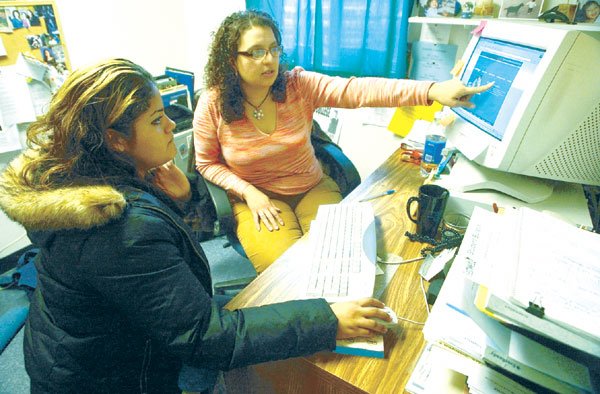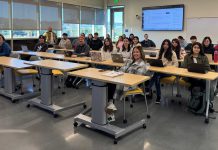Advice available for those who want it, but some parents claim
students not getting enough help
Gilroy – Miriam Arreola has her eye on Chicago.
As she browsed through Web sites about scholarships and schools, the Gilroy High School senior explained that she wants to leave California and study music.
Like many 17-year-olds, Arreola says she’s not sure what career path she’ll take but one things for sure: if she graduates from a four-year university she’ll be the first in her family.
Arreola is just one of the 500 or so students GHS Academic Coordinator Veronica Alfaro serves.
The soft-spoken student doesn’t have Internet at home so she has to schedule her time wisely, taking advantage of the public and school libraries and Alfaro’s open door in the student services building.
That open door has become an issue. One local parent of a college-bound senior said her son’s counselor has yet to meet with him. Other parents have decided to send their children to private school because they say their teens weren’t receiving enough academic advice at GHS.
And, according to a 2005 telephone survey conducted by the American School Counselors Association, parents have little contact with their child’s counselor. Almost 24 percent of the respondents reported having no contact with their child’s school counselor and 13 percent only had one contact last school year.
But with only four ACs responsible for an enrollment of 2,500 students is it realistic to expect one-on-one counseling?
ASCA recommends a student to counselor ratio of 250 to one but Gilroy is close to the national average of 478 to 1.
“I think our caseloads are big but I feel comfortable saying we communicate with every student,” said Rudy Puente, a GHS counselor.
Picking up the clipboard hanging outside of his office, Puente looked over a list of students who had signed up with various academic concerns such as questions about their grade point average, the credits they need to graduate or specifics about a college or scholarships.
If students sign up they will be called in to talk. Also, students can drop in at lunch or brunch for advice.
Alfaro said she would definitely have more time to meet with students one-on-one if the ratio was decreased. Still, the students who want to meet with her get their chance.
“We may see one student more than another because they’re taking the initiative to come in and see us,” said Alfaro.
Laura Mendez and Alicia Jacob can count themselves as those self-motivated students. The two seniors made the trek to the student services building during a rainy, windy lunch this week to sign up for an appointment.
Mendez plans on attending Evergreen Valley College in San Jose and becoming a probation officer while Jacob wants to return to the classroom as a history teacher after transferring to a four-year university from Gavilan College.
The teens, both 17, said they’ve never had a problem connecting with their counselors. Jacob even said college wouldn’t have seemed as attainable without the help of her counselor.
“I just wouldn’t have thought about it,” she said.
Jacob’s satisfaction may have come as a result of some of the changes instituted in the GHS counseling department. Today, GHS counselors’ primary job is to give academic advice, while students with personal problems are referred to social services.
This year students are assigned counselors based on their last names instead of lumping students together based on their area of interest. With the new system students have the same counselor all four years.
The only required meetings for students and counselors occur in the spring when schedules are set for the next school year. Counselors also visit classrooms to talk about the college application process.
Students can also take advantage of the California Student Opportunity and Access Program, an on-campus college preparatory program designed to help first generation college-bound students apply for college. GHS has four Cal-Soap advisors.
When college isn’t their goal, Alfaro talks to her charges about the military or vocational schools.
The options are laid out on the table – literally – in the GHS career center. The abundance of pamphlets on universities are balanced out by an array of brochures from the U.S. Air Force, Marines, Navy, Army and National Guard.
Counselors are there to help guide students down a career path but in the end there’s one objective.
“The end goal is graduation from high school,” Alfaro said.














